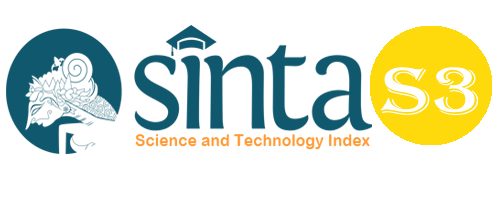Implementation Strategyeco Fishing Portat the Hamadi Fish Landing Base (PPI), Jayapura City, Papua Province
Abstract
This research aims to analyze the public perception of the environmental management system that has been implemented in Hamadi's fish landing base (PPI) and to provide policy strategy recommendations to Local Government regarding the Eco Fishing Port (EFP) implementation at Hamadi PPI. There are 5 aspects that will be examined in the application of eco fishing port concept in a Hamadi PPI, such as; how the environmental management system and the status of its application; how the integrated waste management system; what is the condition of the components of public service facilities; what matters the attention of the management of the fishing port in environmental management; and how the sanitary and hygienic conditions of fish landing sites (TPI). This research used descriptive qualitative method through surveys and interviews. SWOT analysis method used to identify an internal and external factor that influenced the implementation of the Eco Fishing Port, and to find out the best strategy recommendation in order to increase the quality of environment management system at Hamadi PPI. The analysis result shown that the rating value of internal factors (strengths and weaknesses) is 2.510 and the rating value of external factors (opportunities and threats) is -0.175.
Keywords
Full Text:
PDFReferences
Asmuni, et al. (2020). Implementation of the principle of sale and purchase transactions through MLM in Brand Branch (BC) PT. Herba Penawar Alwahida Indonesia (HPAI) Tanjungbalai. Budapest International Research and Critics Institute-Journal (BIRCI-Journal) Volume 3, No. 4, Page: 3376-3385
Edi, IBP, Anggoro, S., & Susilowati, I. (2006). Fishery Port Efficiency Analysis and Development Strategy (Main of Cilacap Ocean Fishing Port Discussion). Journal of Sea Sands, 2 (1), 64-78.
Hermada DekiawanAndHasan Subagyo (2018) Simulation of the SWOT-AHP Model in Determining the Alternative Choice of D3 Vocational Higher Education Development Strategies. Journal of Educational Innovation), 5(1), June 2018
Ministry of Maritime Affairs and Fisheries (2006). PERMEN of Maritime Affairs and Fisheries Number: PER.16/MEN/2006 concerning Fishery Ports.
Marine and Fisheries Ministry. (2009). Law Number 45 of 2009 concerning Amendments to Law Number 31 of 2004 concerning Fisheries. Jakarta: Bureau of Law and Organization, KKP.
Marine and Fisheries Ministry. (2012). Minister of Marine Affairs and Fisheries Regulation Number PER.08/MEN/2012 concerning Fishery Ports. Jakarta: Bureau of Law and Organization, KKP.
Ministry of Maritime Affairs and Fisheries. (2018) Regulation of the Minister of Maritime Affairs and Fisheries Number 6/KEPMEN-KP/2018 concerning the National Fishery Port Master Plan.
Lubis, E. (2000). Introduction to Fishing Ports. Faculty of Fisheries and Marine Science. IPB Bogor
Lubis, E. 2006. Book I: Introduction to Fishing Ports. Bogor: Fisheries Port Laboratory, Department of Fisheries Resources Utilization. Faculty of Fisheries and Marine Science. Bogor Agricultural Institute.
Lubis, E. (2012). Fishing Port. Bogor: IPB Press.
Mulyono, A. (2002). The Role of Bajomulyo Fish Landing Base (PPI) in Supporting Regional Autonomy in Pati Regency. Diponegoro University Postgraduate Program Thesis. Semarang.
Passion Ch. Zebblon, Suzanne L. Undap, and Markus T. Lasut, (2016). Public perception of the implementation of an eco-fishing port at the Bitung Ocean Fishery Port (PPS), North Sulawesi. Journal of Aquatic Science & Management, Vol. 4, No. 1, 21-27 (April 2016).
Prasetyo, EE (2012). Papua's Fisheries Potential is Great. Taken July 31, 2013 from the world wide we siteb http://regional.kompas.com/read/2012/03/14/20312963/twitter.com
Rangkuti, F. (2002). SWOT Analysis Techniques to Dissect Business Cases. Jakarta: PT. Main Library Gramedia.
Riduwan (2004). Thesis Compilation Methods and Techniques. Bandung: Alphabeta.
Supriyanto (2013). Analysis of Environmentally Friendly Fishery Port Management at the Nizam Zachman Ocean Fishing Port, Jakarta. Journal of Environmental Sciences, Environmental Science Postgraduate Program, Riau University.
Sutyawan, F. (2014). Implementation of Eco-Port in Fishing Ports. Presentation materials were delivered at the Socialization Event for Handling Industrial Waste and Fishing Vessels (Ecoport Implementation). Bitung: Bitung Ocean Fishing Port.
Trisna Ningsih (2006). Strategy to Increase Institutional Capacity of Nizam Zachman Ocean Fishery Port, Jakarta
Tumpak Benny Sarialam Haro, Suriani br. Surbakti, Nurhasanah (2014). Journal of Fisheries and Marine Management Vol. 1 No. 1, 2014, article 9. Study of the Role and Strategy of Hamadi Fish Landing Base Management
DOI: https://doi.org/10.33258/birci.v5i1.4187
Article Metrics
Abstract view : 105 timesPDF - 52 times
Refbacks
- There are currently no refbacks.

This work is licensed under a Creative Commons Attribution-ShareAlike 4.0 International License.

This work is licensed under a Creative Commons Attribution-ShareAlike 4.0 International License.

_.gif)

















_.gif)



